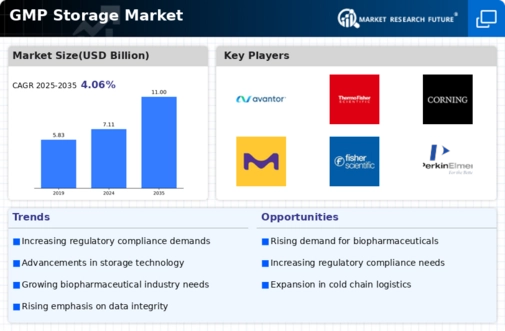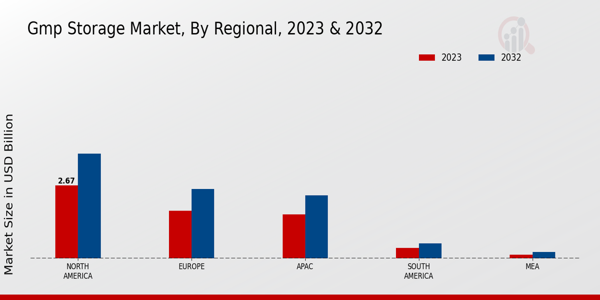Market Growth Projections
The Global GMP Storage Market Industry is projected to experience substantial growth over the next decade. With an estimated market value of 7.11 USD Billion in 2024, it is anticipated to reach 11.0 USD Billion by 2035. This growth reflects a compound annual growth rate of 4.06% from 2025 to 2035, driven by various factors such as increasing regulatory compliance, rising pharmaceutical production, and technological advancements in storage solutions. The market's expansion is indicative of the critical role that GMP storage plays in ensuring the safety and efficacy of pharmaceutical products globally.
Increasing Regulatory Compliance
The Global GMP Storage Market Industry is experiencing heightened demand due to stringent regulatory compliance requirements imposed by health authorities worldwide. Regulatory bodies such as the FDA and EMA enforce rigorous standards for the storage and handling of pharmaceuticals, necessitating facilities that adhere to Good Manufacturing Practices. This compliance ensures product safety and efficacy, which is paramount in the pharmaceutical sector. As a result, companies are investing in advanced storage solutions to meet these regulations, contributing to the market's growth. The industry's value is projected to reach 7.11 USD Billion in 2024, reflecting the increasing emphasis on compliance.
Rising Pharmaceutical Production
The Global GMP Storage Market Industry is significantly influenced by the rising production of pharmaceuticals. As the global population grows and healthcare demands increase, pharmaceutical companies are ramping up production to meet these needs. This surge in production necessitates efficient storage solutions that comply with GMP standards. For instance, the expansion of biopharmaceutical manufacturing facilities has led to a greater need for specialized storage environments. The market is expected to grow to 11.0 USD Billion by 2035, indicating a robust demand for GMP-compliant storage as production scales up to meet global health challenges.
Global Health Initiatives and Investments
Global health initiatives and investments are significantly influencing the Global GMP Storage Market Industry. Governments and international organizations are increasingly funding healthcare projects aimed at improving access to medicines and vaccines. This influx of investment often necessitates the establishment of GMP-compliant storage facilities to ensure the safe and effective distribution of medical products. As countries prioritize healthcare infrastructure, the demand for compliant storage solutions is likely to rise. This trend underscores the importance of GMP storage in supporting global health objectives and enhancing the overall pharmaceutical supply chain.
Growing Demand for Biologics and Biosimilars
The Global GMP Storage Market Industry is also driven by the growing demand for biologics and biosimilars. These complex products require specialized storage conditions to maintain their stability and efficacy. As the biopharmaceutical sector expands, the need for GMP-compliant storage solutions becomes more pronounced. Companies are investing in facilities that can accommodate the unique requirements of these products, which often include stringent temperature and humidity controls. This trend is expected to contribute to the market's growth, as the industry adapts to the evolving landscape of drug development and production.
Technological Advancements in Storage Solutions
Technological advancements are playing a crucial role in shaping the Global GMP Storage Market Industry. Innovations such as automated storage systems, temperature monitoring technologies, and smart inventory management solutions enhance the efficiency and reliability of GMP storage. These technologies not only ensure compliance with regulatory standards but also optimize operational costs for pharmaceutical companies. As organizations increasingly adopt these advanced solutions, the market is likely to witness a compound annual growth rate of 4.06% from 2025 to 2035. This trend suggests a shift towards more sophisticated storage practices that align with modern manufacturing needs.








